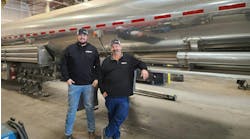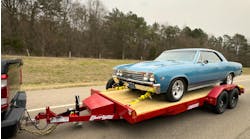Phoenix. Uptime, uptime, uptime. Commercial vehicle owners demand it; equipment OEMs have made it their mantra; and, ultimately, it’s up to the aftermarket parts supply chain to make it happen.
To that end, SAF-HOLLAND recently opened a new western region Aftermarket Distribution Center here. The SAF-HOLLAND goal for the location is single-day response service for the western United States. To achieve that, as company executives explain to Trailer/Body BUILDERS, SAF-HOLLAND must streamline the ordering, packing, and shipping process for their distributors and end users, while still offering a comprehensive range of products—trailer suspension and axle systems, truck suspensions, fifth wheels, landing gear, coupling products, and the many associated parts and accessories.
Recognizing the trend, SAF-HOLLAND opened a large aftermarket distribution center in Cincinnati in 2011 but that location simply can’t serve the entire customer base with the speed the market demands.
“That’s why this warehouse is important for the West. These customers will have immediate availability of product, which maximizes uptime,” says Lance Hampton, SAF-HOLLAND sales manager for the western region. “That’s really what it’s about. It’s making sure that the customer is up and running as quickly as possible. They didn’t buy their equipment so it could sit idle.”
The site near I-10 is surrounded by massive new warehouses. As of this summer, the greater Phoenix market had nearly 8 million square feet of industrial space under construction.
Amazon has four fulfillment centers nearby, and other recent additions include UPS, Chewy Inc, Dick’s Sporting Goods, Recreational Equipment Inc (REI), Macy’s – Bloomingdale’s, and Sub-Zero. Daimler Trucks North America will soon open a distribution nearby as well.
“Customers recognize and appreciate the SAF-HOLLAND investment and effort,” adds Michael Keller, director of sales for aftermarket, regional fleet and dealer.
“We want our customers, our distribution partners, to want to do business with us,” Keller says. “So the more we can ease their process, keep the product from being damaged, and increase safety, the better a partner we are for them.”
Hampton agrees, noting that the SAF-HOLLAND warehouse teams and their customers both have inventory KPIs to meet.
“It’s all about being a partner with our customers and helping them achieve their goals,” Hampton says. “And once we do that, it will be easier for us to achieve ours.”
Indeed, 100% customer satisfaction is the mission statement for the warehouse teams, notes Beau Foss, aftermarket warehouse manager for the Cincinnati and Phoenix facilities.
“It’s either right or it’s wrong,” he says. “There’s no if-ands, there’s no in between. And we want to make sure that customer experience is the same for everybody.”
Process improvement
Foss has built a career from organizing warehousing and distribution facilities. Brought in to set up the new SAF-HOLLAND warehouse, Foss drew from some of the lessons learned from the Cincinnati facility—adopting many, adapting some.
“This [Phoenix] building goes back to before I hired on, and we had this conversation about Carl’s vision for the aftermarket distribution center,” he says, referring to Carl Mesker, SAF-HOLLAND vice president, sales, Americas. “We needed to go in and figure out how we wanted to properly handle the parts in Cincinnati, put that process in place, and then we want to emulate that out here.”
A Cincinnati redesign included tearing out the shipping office, which sat in the middle of the warehouse—and made it impossible to organize the product flow efficiently. Among other improvements, Foss brought in “push back racking,” a pallet rack system that stores pallets on wheeled carts that rest on rails and operates using the force of gravity. Such a racking system recovers warehouse space lost to stacked pallets.
He also installed a bridge crane to allow warehouse workers to safely handle heavy, bulky fifth wheels.
“We basically took the Cincinnati DC, and with about one-third that size we modeled that here. And then we did some improvements that we couldn’t do in Cincinnati because of the building constraints,” Foss says, pointing out that the new building has more height, among other things.
Safety is the first priority, Foss emphasizes. And it’s important for warehouse personnel to understand the product. He notes that the SAF-HOLLAND packing guidelines run to almost 300 pages.
“Our job is to make sure that the customer gets the parts accurately, in good condition and in a safe form,” Foss says. “And the more efficient you are in packing, the more cost savings you get on the freight side, too.”
Products coming into the DCs are not packaged for distributors or end users, so repackaging is their primary purpose. Still, since SAF-HOLLAND is also a parts manufacturer, couldn’t the factories package the product for distribution? Simply, no—that’s not their job, as Mesker explains.
“Our manufacturing plants are built to serve the OEMs, and they need parts packaged totally differently” Mesker says. “I don’t want to recreate shipping and packaging six times at our six different manufacturing plants and have to train six different people how to do the packaging. I’d rather just send it all in here: We have the expertise here to handle it, to put it into aftermarket packaging, and ship it.”
He notes that SAF-HOLLAND has, in the past, tried to rely on a 3PL for product distribution—but it has proven to be “a train wreck” because the logistics expert wasn’t an expert in commercial vehicle products, and couldn’t meet the wide range of customer packaging and shipping needs.
Hampton explains the impact of product complexity on parts distribution.
“When you take a look at all our different brands—everything, pretty much, undercarriage—you’re not going to have a 3PL come in and do bumper tubes, landing gear, fifth wheels, top plates. These are all different sizes, shapes, and what have you,” Hampton says. “If you’re dealing with one product mix, maybe it’s a little bit easier because the dimensions are all similar. But with our offering, they’re completely dissimilar; no one product is like another.”
And that’s a challenge for the SAF-HOLLAND distribution team as well, and one that’s constantly being evaluated.
So, for example, properly packaging heavy pieces for shipment is critical. The model 351 fifth wheels formerly were shipped with multiple units banded together in a stack on a single pallet. Accessing one unit meant cutting them all loose—which was subject to accidents. A redesigned stackable pallet set allows a forklift operator to remove one fifth wheel at a time while the rest of the stack remains stable.
“It shouldn’t matter whether it’s Phoenix or it’s Cincinnati, or if it’s a first shift or second shift, that product should go out and it should be identical,” Foss says. “It should be one continuous, sustainable process. And that’s what we’ve been working on for the last two years. I think we’ve gotten to a point where we have the processes in place, we just need to execute.”
And because the Phoenix facility eliminates many of the LTL shipments from Cincinnati, the risk of damage from a cross-county, multi-hub transit is reduced. Additionally, as Keller points out, the time difference in Phoenix will allow the new DC to better serve customers in the central US through the additional hours of shipping availability.
“I think that really comes into play with truck-down issues,” Keller says. “The extra two hours for the next-day air cut-off time goes a long way for a customer who knows they can get that part out of Phoenix now.”
DC layout
To open, the nearly 45,000-square-foot facility will operate with a staff of 23. The building has seven doors, with five docks—three for outbound and two inbound. The facility also will feature a will-call counter, although the area has yet to be set up pending an early assessment of how much local business to expect.
The Phoenix DC stocks more than 2,000 SKUs, and closely tracks “fast-moving” parts, with demand rated as A, B, and C.
The facility is served by five primary LTL carriers, and has two expedited pickups each day.
The larger, hard-to-handle products are stored as close to the loading dock as possible. The flow throughout the rest of the facility could then be optimized for efficiency.
“And that’s easy to do with a new building, because you don’t have to move all that extra product [as in a redesign]—you don’t have all those bad practices in place, those bad habits,” Foss says.
Likewise, warehouse personnel from Cincinnati have come to Phoenix to help with training new workers and to become familiar with the new location and processes.
“I want to make sure that we team together to make sure that they know that Phoenix isn’t out here all alone,” he says. “And we want to share practices, because we may do something better out here than we do in Cincinnati, and I want to share that. It’s to become more efficient, both ways.
“You’ll have somebody come in, with the building brand new, and say ‘why do you do that?’ And they just keep asking ‘why,’” Foss continues. “And sometimes they’re right, and we’ll make changes.”
Bigger changes
“We are reinventing this entire company,” says Mesker. “Every process, every procedure, every touchpoint with the customer, step by step. Phoenix is just one of the things you’re going to see coming out that are going to be different in the future.
“There’s dozens of things that are happening—at the OEM level, on the aftermarket side—changes that we’re putting into place. Even the phone system that our customer service group uses, and how we measure our responsiveness to the customer, is completely different than what we have ever done before. We’ve totally reworked our CRM [customer relationship management] from what we had before.”
Those changes “inside the walls” at SAF-HOLLAND won’t matter, however, until there’s a benefit to the customer. So, externally, Mesker suggests that announcements to be made at this month’s North American Commercial Vehicle (NACV) show will be the first of many new products and initiatives aimed at OEMs, truck drivers, and the aftermarket.
Mesker also points to the new, “much more user-intuitive” e-commerce website to support parts-on-demand orders.
“If we have to train our customers how to use it, it failed,” he says of the e-commerce site, but the project captures the spirit of the broader shift at SAF-HOLLAND. “We’re trying to make it easier for the customer to do business with us.”









